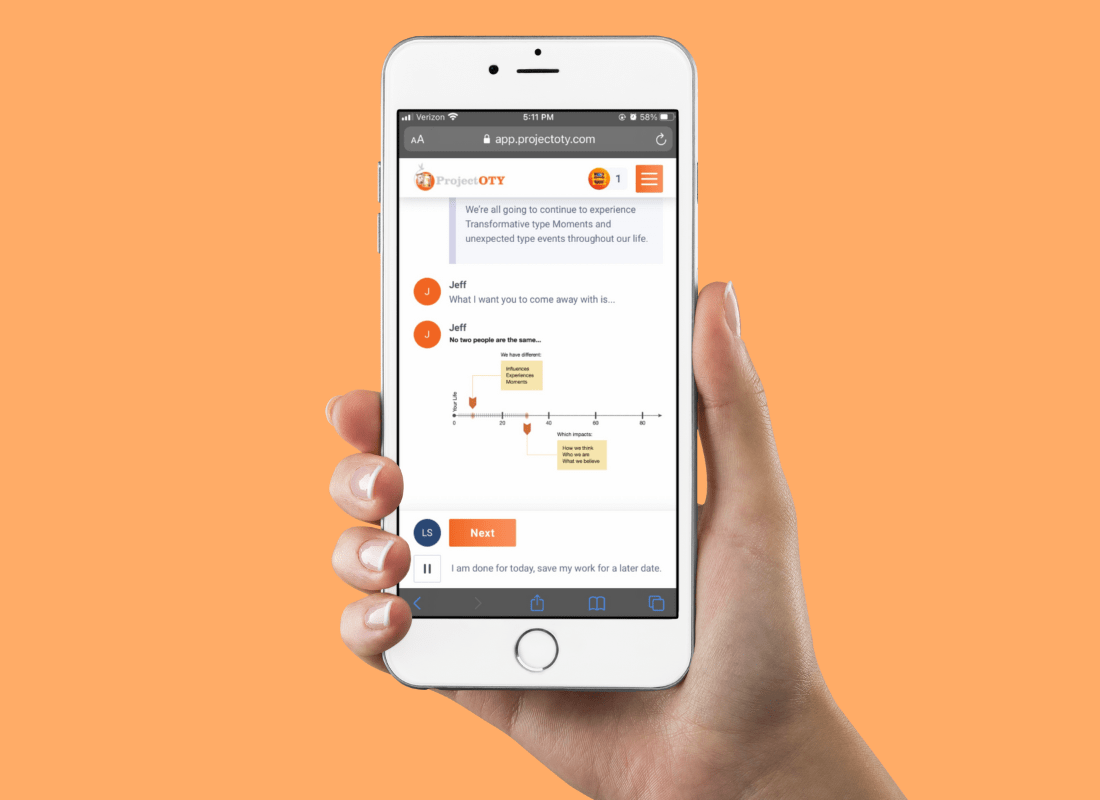When you think about gratitude, saying “thank you” comes to mind. Intentionally saying “thank you” to someone might be one of the easiest ways to practice gratitude.
However, in talking about gratitude, we want to take the idea of giving thanks a step further…
How are you making time to intentionally be thankful for the good in your life on an everyday basis?
Gratitude is something that our team feels strongly about, to the extent that it’s a part of our weekly meetings and journaling practices. We wanted to dedicate a post to explaining the benefits of gratitude (i.e. it does way more than make you and those around you “feel good”).
We also share the small ways that you can get started with practicing gratitude in your daily life. Finally, we’ll share a couple of exercises that we practice amongst our team, which we dive deeper into on our personal leadership platform, Project OTY.
So let’s first (quickly) define what gratitude is.
What does gratitude mean?
Gratitude goes beyond thanking someone for opening the door for you at your local coffee shop. Oftentimes, the common act of expressing thanks in our day-to-day life feels like an unconscious reaction. We give thanks out of courtesy to others (most of us are good humans that way).
That being said, gratitude is an emotion that centers around consciously appreciating and acknowledging actions and events within your life.
Robert Emmons, the thought leader on gratitude, notes that there are two components to gratitude:
- Noting the good things that you have received
- Recognizing the role that people or external factors play in receiving these good things
So, why is gratitude important?
Like exercising or getting decent sleep, practicing gratitude has many noted health benefits.
Gratitude helps combat negative emotions.
Dr. John Medina, a molecular biologist focused on human brain development, notes in his book “Brain Rules” on the impact of gratitude.
He shares that shifting your thoughts from your problems and burdens to acknowledging the support around you, can be extremely helpful in combating stress.
Practicing gratitude is also shown to help those facing anxiety and depression. In the process of shifting your thought process, your brain produces its feel-good chemicals – serotonin, dopamine, and oxytocin. As a result, gratitude supports a better mood and higher levels of happiness and self-esteem.
Gratitude is by no means a cure-all. However, it goes a long way to challenge negative thought processes and lead to a more positive outlook.
Gratitude affects the way you think.
You might be surprised to learn that gratitude can have a long-term impact on your brain.
UC Berkeley ran a study with individuals who wrote a letter of gratitude and performed a “pay it forward” action of donating money to a charity. Not only did grateful individuals donate more, but they found that people who wrote gratitude letters had greater activity in their fMRI brain scans.
The activity in this part of the brain is best explained by Ellie Cobb, Ph.D., a holistic psychologist:
“People who intentionally cultivate gratitude show greater neural sensitivity in the medial prefrontal cortex, a brain region associated with learning, rational thinking and decision making.”
This effect was found nearly 3 months after the study took place, suggesting that your brain becomes familiar with the feeling (and expression) of gratitude.
It impacts your physical health.
Gratitude does more than just impact your brain. In a cross-analysis of studies, gratitude helped individuals sleep better and supported improvements in people’s blood pressure and eating behaviors.
According to a 2012 study, gratitude was tied to people reporting better physical health, with fewer aches and pains. Grateful people were also noted as being more likely to take action to care for their health, including attending routine checkups and exercising.
You feel more connected.
Gratitude allows you to plant yourself in reality. You feel more grounded. In other words, you feel more connected to yourself, those around you, and the unique and transformative moments you experience in life.

In this sense, practicing gratitude also lends itself to a “ripple effect”. Gratitude encourages paying good deeds forward, according to sociologist Georg Himmel. Research notes that positive emotions, like gratitude, motivate positive actions and change. All this is to the benefit of those closest to you, and your community!
How to Practice Gratitude in a Healthy Way
Now…we want to share some best practices when it comes to practicing gratitude.
Believe it or not, gratitude can evolve into personal gaslighting and involve feelings of guilt. It’s very easy for gratitude to become a way for you to invalidate your own experiences, especially in comparison to others.

For example, you might look at a post on social media of a natural disaster or world event and think to yourself, “I don’t have it that bad. I have XYZ. They don’t.”
What you feel and experience matters. Here’s how to structure your gratitude practice in a way that preserves your mental health and wellness in the process.
Express gratitude where you feel it most: For gratitude to work best, you want to experience true thankfulness. If you’re not feeling grateful for your job or a part of life that isn’t sparking joy, don’t force appreciation.
Avoid comparisonitis: The quote “comparison is the thief of joy”, is true here. Going down the rabbit hole of comparison often leaves you feeling guilty for feeling ungrateful when other people seem to have it worse. You are not wrong for expressing your true feelings.
Validate your feelings: Going along with the above point, you can practice gratitude even when life isn’t so rosy. Practicing gratitude can help combat negative feelings but it doesn’t overwrite them or belittle them. For example, you can be grateful for your job, but that doesn’t mean that you don’t still feel the stress of work assignments and deadlines.
5 Easy Ways to Add Gratitude Into Your Day
Gratitude isn’t something you practice with an overnight impact, but from what we shared above, you now know it has an obvious long-term benefit.

By practicing gratitude, you effectively train yourself to feel thankful more often in life. Here are a couple of ways to easily add gratitude into your daily routine:
Say thank you to someone in your life. We include this as a dedicated exercise in the Project OTY platform. Overall, going out of your way to recognize the way that people have helped you in your life speaks volumes to others. We recommend sending a text message or email to at least one person a week.
Observe the little moments. Gratitude can be expressed for a lot of big-picture aspects of life. The small things in life are just as important though. You can be grateful for the sun warming your skin, the smell of a candle, the taste of homemade chocolate chip cookies, the cold side of a soft pillow…the list is endless. Take time to notice the little things in life.
Think back to previous obstacles. This one might feel contradictory, but it’s worth it to include it in your gratitude ritual. Think back to a problem you faced a year ago. How have things changed? How have you grown? Take the time to express gratitude for any lessons you’ve learned and how you’ve evolved as a human being in the process!
Post visual reminders. Whether you list them out or journal them, set your “gratitude notes” in a place where you can look at them throughout the day, or even just review them at the end of the day. You’ll be surprised at how helpful this reminder can be.
Try gratitude journaling. Journaling can be a great way to let off steam and unload your thoughts. According to a 2011 study, jotting down what you’re thankful for before bed helps improve sleep! A daily gratitude journal is an option for those who are ambitious, but you easily see the benefits of journaling 1-2 times per week. If you’re new to journaling and feel intimidated, we recommend the exercise below, which is the structure we follow in the Project OTY platform.
Try These Two Simple Gratitude Exercises
We can feel crunched for time sometimes, but these two exercises can go a long way to making your (or another person’s) day. They’re worth taking a few minutes out of your day.
At home (or wherever you are currently): Grab a pencil and a piece of paper and make a gratitude list. List 3-5 things you’re grateful for. We recommend doing this first thing in the morning and taking your time to outline it.
If you need additional help making a list, use these gratitude prompts.
Estimated time: 5-10 minutes
In the workplace: During a meeting, dedicate a part of your meeting to going around and sharing what you’re grateful for. This could be related to work or a team member’s help on a project, but it could also reflect the simple joys you appreciate in your personal life.
Estimated time: 10-15 minutes
Practice Gratitude & Create a Future Plan
Getting started with gratitude and healthier habits can sometimes feel intimidating. At Project OTY, we have a 16-step process to develop the mindset of a leader, and confidently lead the life you want!
We give a more in-depth look at gratitude and other exercises within our personal leadership platform. Sign up here to get started for free.



